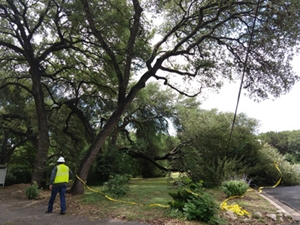Tree Trimming
Tree Trimming and Vegetation Management
Austin Energy Forestry Division
Austin Energy takes our responsibility to deliver safe and reliable energy to our customers seriously. Expert tree trimming and vegetation management help make that possible.
Weather and vegetation cause more than one in three outages in our area.
- During windy and stormy weather, swaying and broken tree limbs can rub against wires or bring down power lines.
- In extreme cold, ice can add heavy weight and bring wires in contact with trees which may also lead to down power lines.
- All of this can cause service fluctuations, widespread outages, hazardous conditions and fires.
Trees that grow too closely to power lines also pose an unnecessary risk to customers who depend on uninterrupted power for life support.
Untrimmed trees:
- Increase the likelihood of fires from arcing electricity.
- May cause electrical shock, serious injuries or fatalities to anyone who comes into close contact with an energized tree.
-
The National Electrical Safety Code requires Austin Energy to keep branches clear of power lines. And, we want to do our part to keep the community safe and protect our customers from power line hazards.

Benefits of Proper Tree Trimming
Managing trees and other vegetation near energized power lines maintains public safety. Proper vegetation management also:
- Improves electric reliability by preventing some of the most common causes of outages.
- Prevents damage to electrical infrastructure.
- Provides utility crews safe access to equipment for repairs, which allows for quicker power restoration.
- Protects and promotes the health of your trees.
- Supports the City of Austin's and the Austin Fire Department's Firewise Program and enhances public safety awareness to minimize tree/wire conflicts to reduce fire risk.
When Trees Are Not Properly Maintained
- Improper vegetation management — trees that have not been adequately trimmed and other vegetation that encroaches on power lines — is responsible for many outages.
- Some of these outages require lengthy restoration times, as they require extensive trimming and multiple crews to repair power line damage.
- Improper vegetation management can also be responsible for voltage fluctuations or "momentary" outages, as branches can scrape across lines even on "blue sky" days.
During widespread storm events, power restoration is our priority. Branches can break off or sag and damage power lines — especially during storms with heavy winds, hail, sleet, and ice.
Often, our crews must trim damaged tree limbs before safely repairing the electric system.
Austin Energy will not remove debris or brush that results from power restoration. Check the Austin Resource Recovery residential guidelines and schedule for curbside brush collection. Customers outside of the City of Austin should contact their local municipality.
Trimming Cycles and Practices
In 2019, Austin Energy increased our tree trimming clearances to increase reliability and safety and to keep our customers and communities safe. These clearances help us adapt to and address the increasing threat of wildfire and extreme weather.
These tree trimming clearances mean trees will be trimmed to keep limbs clear of the power lines for seven years. However, some fast-growing species may require trimming during the mid-point of cycles to maintain proper clearances from energized lines.
These trimming cycles are ideal to protect the health of your trees, ensure public safety and electric reliability, and assist with reducing the significant expense of tree trimming.
Austin Energy's trimming cycle requires work planning along more than 2,400 miles of power lines. Each year, hundreds of miles of Austin Energy power lines are scheduled for tree trimming or tree removal on 9,000 to 12,000 properties a year.
Austin Energy's Forestry Division uses three contractors to help with tree trimming across the service area. The three contractors are: Asplundh, Davey Tree, and Wright.
Standard Clearances:
- Fast-growing species (e.g., Ligustrum, China Berry, Hackberry, and Pecan): 15 ft.
- Slow-growing species (e.g., Cedar, Cedar Elm, and Juniper): 10 ft.
Factors We Consider When Trimming Trees:
- Tree species
- Time of year
- Oak wilt and bird habitats — We make every effort to avoid trimming red oak and live oak trees between February and June when oak wilt is more likely to spread. To protect bird habitat areas, when possible, we avoid trimming from March to September (applies to undeveloped areas west of MoPac).
- Circuit, line fuses, and customer ticket requests — We trim trees along a circuit from beginning to end on maintenance schedules. We trim trees along a line fuse section or area identified in a ticket request. If a portion of the circuit or line fuse is not trim and a tree limb falls on the line, the entire area may experience a power outage.
For More Information
- Please visit our Tree Trimming FAQs to find answers to commonly raised questions about our tree trimming program.
- If you need more information, please call Customer Care at 512-494-9400 or email the Austin Energy Forestry Division.
